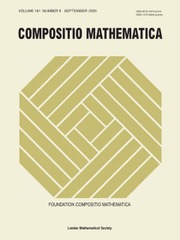Article contents
Chai's conjecture for semiabelian Jacobians
Published online by Cambridge University Press: 24 March 2025
Abstract
We prove Chai's conjecture on the additivity of the base change conductor of semiabelian varieties in the case of Jacobians of proper curves. This includes the first infinite family of non-trivial wildly ramified examples. Along the way, we extend Raynaud's construction of the Néron lft-model of a Jacobian in terms of the Picard functor to arbitrary seminormal curves (beyond which Jacobians admit no Néron lft-models, as shown by our more general structural results). Finally, we investigate the structure of Jacobians of (not necessarily geometrically reduced) proper curves over fields of degree of imperfection at most one and prove two conjectures about the existence of Néron models and Néron lft-models due to Bosch–Lütkebohmert–Raynaud for Jacobians of general proper curves in the case of perfect residue fields, thus strengthening the author's previous results in this situation.
MSC classification
Information
- Type
- Research Article
- Information
- Copyright
- © The Author(s), 2025. The publishing rights in this article are licensed to Foundation Compositio Mathematica under an exclusive licence
References
- 1
- Cited by


